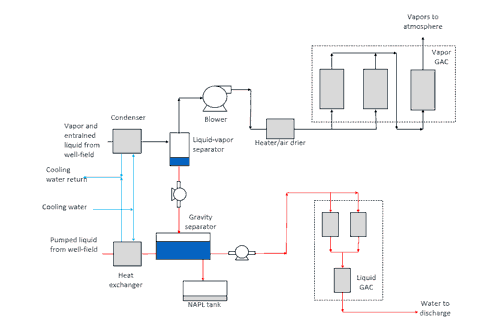When it comes to thermal remediation treatment systems, extracting the contaminants from the ground is only one part of the solution – another important component is addressing the vapor and liquid fluids extracted from the wellfield. These fluids need to be treated before they’re safe to release.
Luckily, the fluids can be addressed using one of several conventional methods. However, because there’s more than one treatment method, it can be difficult to review proposals from solution providers – you’re almost certainly not comparing apples to apples. As a result, it’s difficult to determine which treatment solution would be most effective and cost-efficient for your project.
In this blog post, we’ll clear up some of the confusion by breaking down your options for both vapor and liquid treatment and look at the benefits and limitations of each.

Oxidizer vs. GAC for Vapor Treatment
No matter the below-ground thermal remediation technology, be it Thermal Conduction Heating (TCH), Electric Resistance Heating (ERH), or Steam Enhanced Extraction (SEE), the majority of the fluid coming from the wellfield will be in the vapor phase. Extracted vapors can contain anywhere from 30% to 60% moisture, and the rest consisting of non-condensable vapors (air) and the contaminants of concern (COC). Additionally, for most sites and COCs, 90 to 95% of the contaminant mass removed will be in the vapor phase.
The first step in any vapor treatment system is to remove the moisture. Not only will that help minimize the size of the downstream treatment equipment, but it will also protect both rotating equipment (forced draft or induced draft blowers) and any activated carbon (commonly used to treat contaminated vapors).
Moisture removal consists of cooling the vapors by passing them through a heat exchanger. This condenses the moisture out, but it also releases a certain amount of the COC. As these are often chlorinated compounds (for example, TCE and its byproducts), material selection is an important consideration when designing the up-front condenser. Customarily, a vapor liquid knock-out pot is paired with this unit to ensure the liquid fully disengages from the vapor and is not inadvertently carried downstream. This liquid condensate is sent to the liquid treatment system for further disposition.
Once the moisture is removed, the COC can now be dealt with more readily. The remediation choices at this stage are oxidation and absorption. For large COC loadings, oxidation is the obvious choice, as the cost to continually change out spent adsorbent is prohibitive. That said, oxidizers should always have an adsorbent as a backup treatment method should the oxidizer need to be taken offline for any reason.

For smaller amounts of COC, the economics revert to using an adsorbent. In most cases, granular activated carbon (GAC) is sufficient, as it has a good affinity for a wide range of compounds, although, for certain compounds like Vinyl Chloride (VC), Potassium Permanganate (KMnO4) is a better option.

To move the vapors through the treatment system, a suitably sized blower is installed in the vapor treatment train. Proper blower location depends on several factors. A properly sized blower will not only have enough static pressure to achieve proper vacuum at the wellfield to enhance extraction, but it will also push the vapors up and out the stack, ensuring clean contaminant-free exhaust at the point of discharge.
Some Key benefits and drawbacks of either approach are summarized below.

When it comes to treating liquids, the major challenge is separating the aqueous (liquid water) phase from the organic phase (commonly termed NAPL, which is short for “non-aqueous phase liquid”). This is customarily done by an Oil Water Separator (OWS) unit.
To enhance the effectiveness of the separation, the incoming liquid is often cooled and almost always filtered to prevent any particulate fouling. The NAPL is further subdivided into two categories: DNAPL, which is denser than water, and LNAPL, which is lighter than water. DNAPL will tend to sink to the bottom of the separator, where it can be pumped out periodically. LNAPL and will float on the top of the aqueous phase and can be skimmed off. Both LNAPL and DNAPL can be collected in suitably sized holding tanks.
Finally, the water in the OWS unit will require treatment. As it will almost always have trace amounts of organic containments, it should be passed through active carbon prior to discharge, thereby ensuring the liquid side of the treatment system is also in compliance with local regulations.
The above-ground components of a thermal remediation treatment system are not as exciting as what occurs in the subsurface, but they are equally important. Hopefully, you now have a better understanding of your options for treating extracted wellfield fluids, no matter the phase.
Still have questions? Contact me, I’m happy to help.
06.23.21

